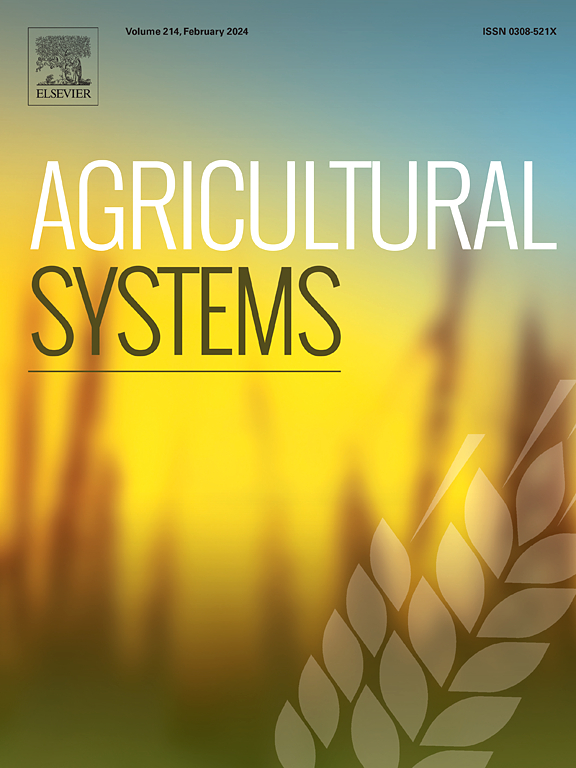A comparative study of the legal and regulatory dimension of seed sector development in Sub-Saharan Africa using regulatory systems maps: The case of Ethiopia, Rwanda, and Uganda
IF 6.1
1区 农林科学
Q1 AGRICULTURE, MULTIDISCIPLINARY
引用次数: 0
Abstract
Context
Harmonization of Africa's rules and regulations for seed sector development began several decades ago through efforts of its regional economic communities. This process of regional alignment has, to a degree, incorporated a more pluralistic approach that considers and acknowledges that multiple seed systems make up the seed sector and that national legal systems may contain different innovations and flexibilities. With deeper continental integration foreseen under the African Continental Free Trade Area, the focus on regional alignment of agricultural rules in Africa has increased. While this presents an opportunity for policy and regulatory change in support of seed sector development, deeper study is warranted of how regional and national policy and regulatory systems align and where differences could advance greater equity in seed systems.
Objective
This study aims to analyze and compare the legal and regulatory dimensions of seed sector development in Sub-Saharan Africa by identifying areas of convergence and divergence across both law and practice in national legal systems.
Methods
The study applies a relatively novel method—Regulatory Systems Mapping—that allows for both comparative and contextual analysis. The methodology focuses on four qualitative comparative criteria (efficiency, legal design, implementation, and flexibility and equity) to highlight stakeholder experiences and good practices in seed sector development. The method is applied to three countries (Ethiopia, Rwanda, and Uganda), all of which are members of the Common Market for Eastern and Southern Africa and have reformed domestic law in line with various regional agreements.
Results and conclusions
The study finds both differences and similarities between the three countries in terms of practices, flexibilities, alignment, needs, and gaps in the legal and regulatory dimensions of seed sector development, particularly with respect to areas in which written law differs from stakeholder experience. These findings suggest the need for several national-level interventions and a review of regional rules and procedures to integrate flexibility and stakeholder priorities in legal and regulatory design and implementation.
Significance
The study not only contributes to the growing body of literature on African policy and regulation for seed sector development but also details a novel methodological approach to comparing seed regulatory systems, with emphasis on analytically isolating intervention points, legal innovations, and fit-for purpose pluralistic approaches. This analysis provides the kind of evidence that policymakers need to improve regulatory systems to better address dimensions such as flexibility and equity that reflect farmers' needs, reduce costs, and increase participation in seed systems.

使用监管系统地图对撒哈拉以南非洲种子部门发展的法律和监管层面进行比较研究:以埃塞俄比亚、卢旺达和乌干达为例
几十年前,通过区域经济共同体的努力,非洲种子部门发展的规则和条例开始协调一致。这一区域协调进程在一定程度上包含了一种更加多元化的方法,考虑并承认多种种子系统构成种子部门,国家法律系统可能包含不同的创新和灵活性。随着非洲大陆自由贸易区所预见的更深层次的大陆一体化,对非洲农业规则区域一致性的关注有所增加。虽然这为政策和监管改革提供了机会,以支持种子部门的发展,但有必要对区域和国家政策和监管系统如何协调以及差异在哪些方面可以促进种子系统的更大公平性进行更深入的研究。本研究旨在通过确定国家法律体系中法律和实践的趋同和分歧领域,分析和比较撒哈拉以南非洲地区种子部门发展的法律和监管层面。方法本研究采用了一种相对新颖的方法——调控系统映射——允许比较分析和上下文分析。该方法侧重于四个定性比较标准(效率、法律设计、实施以及灵活性和公平性),以突出利益相关者在种子部门发展方面的经验和良好做法。该方法适用于三个国家(埃塞俄比亚、卢旺达和乌干达),它们都是东部和南部非洲共同市场的成员,并根据各种区域协定改革了国内法。结果和结论研究发现,在种子部门发展的法律和监管层面,特别是在成文法与利益相关者经验不同的领域,这三个国家在实践、灵活性、一致性、需求和差距方面既有差异,也有相似之处。这些调查结果表明,需要在国家一级采取一些干预措施,并审查区域规则和程序,以便在法律和监管的设计和实施中结合灵活性和利益攸关方的优先事项。该研究不仅为非洲种子部门发展的政策和监管文献做出了贡献,而且还详细介绍了一种比较种子监管制度的新方法,重点是分析隔离干预点、法律创新和适合目的的多元化方法。这一分析提供了决策者改善监管体系所需的证据,以更好地解决反映农民需求、降低成本和增加对种子系统参与的灵活性和公平性等问题。
本文章由计算机程序翻译,如有差异,请以英文原文为准。
求助全文
约1分钟内获得全文
求助全文
来源期刊

Agricultural Systems
农林科学-农业综合
CiteScore
13.30
自引率
7.60%
发文量
174
审稿时长
30 days
期刊介绍:
Agricultural Systems is an international journal that deals with interactions - among the components of agricultural systems, among hierarchical levels of agricultural systems, between agricultural and other land use systems, and between agricultural systems and their natural, social and economic environments.
The scope includes the development and application of systems analysis methodologies in the following areas:
Systems approaches in the sustainable intensification of agriculture; pathways for sustainable intensification; crop-livestock integration; farm-level resource allocation; quantification of benefits and trade-offs at farm to landscape levels; integrative, participatory and dynamic modelling approaches for qualitative and quantitative assessments of agricultural systems and decision making;
The interactions between agricultural and non-agricultural landscapes; the multiple services of agricultural systems; food security and the environment;
Global change and adaptation science; transformational adaptations as driven by changes in climate, policy, values and attitudes influencing the design of farming systems;
Development and application of farming systems design tools and methods for impact, scenario and case study analysis; managing the complexities of dynamic agricultural systems; innovation systems and multi stakeholder arrangements that support or promote change and (or) inform policy decisions.
 求助内容:
求助内容: 应助结果提醒方式:
应助结果提醒方式:


